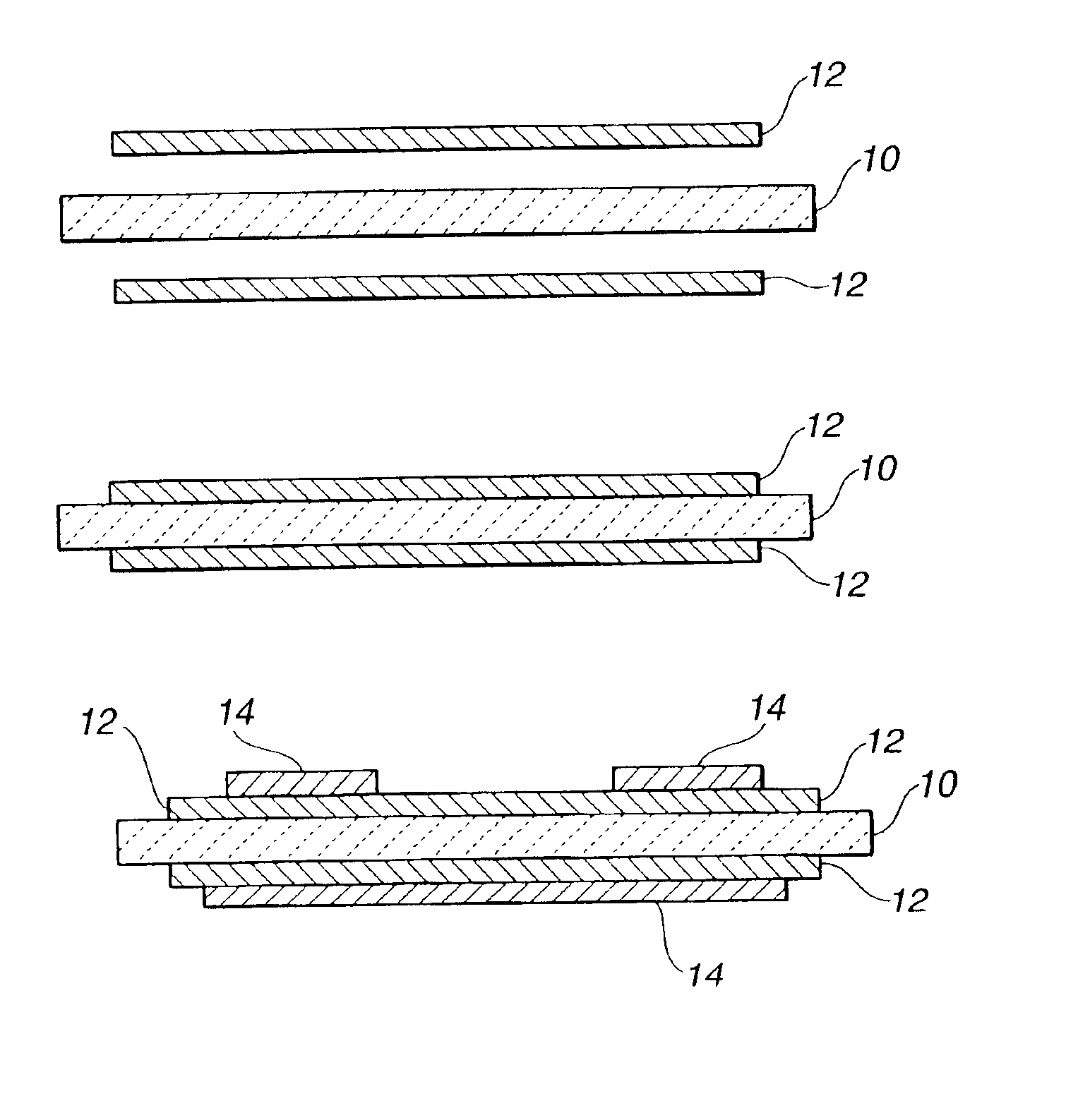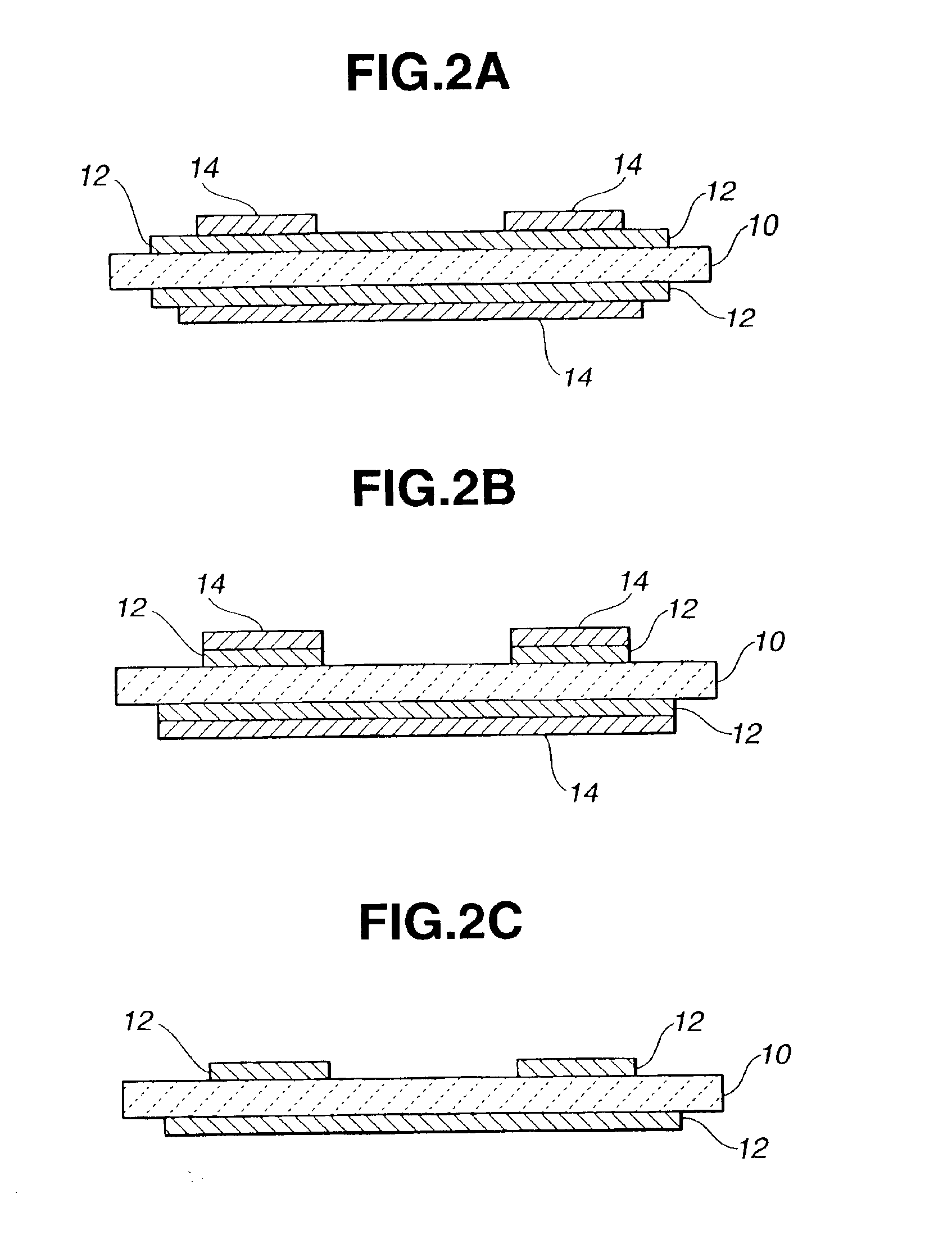Metal/ceramic bonding article and method for producing same
a technology of metal/ceramic bonding and metal/ceramic, which is applied in the manufacture of cables/conductors, metallic pattern materials, solid-state devices, etc., can solve the problems of resistor easy to occur, bonding failure, and deterioration of productivity, so as to reduce the displacement failure of parts and improve productivity.
- Summary
- Abstract
- Description
- Claims
- Application Information
AI Technical Summary
Benefits of technology
Problems solved by technology
Method used
Image
Examples
example 1
Plates of a Cu—Ni—Mn alloy (manganin) having a size of 56×75 mm□ and a thickness of 0.2 mm and serving as a resistive alloy were arranged directly on both sides of an alumina substrate having a size of 60×80 mm□ and a thickness of 0.635 mm to be heated in an atmosphere of nitrogen to a maximum temperature of 975° C. to obtain a metal / ceramic bonding article. Then, resists having a size of 48×68 mm□ (MT-UV-5203 produced by Mitsui Chemical Co., Ltd.) were printed on the manganin plates, and the manganin plates were etched with a copper chloride solution to remove undesired portions of the manganin plates. Then, the resists were removed.
With respect to ten substrates thus obtained, the displacement fraction defective was measured on the basis of ±0.2 mm as a criterion, so that the displacement fraction defective was 0%.
example 2
An alumina substrate having a size of 60×80 mm□ and a thickness of 0.635 mm was prepared, and a break line processing was carried out so as to separate the alumina substrate into 35 regions, each having a size of 10×10 mm□, while ensuring a dummy portion of 5 mm in the edge portion thereof. Thereafter, plates of a Cu—Ni—Mn alloy (manganin) having a size of 56×75 mm□ and a thickness of 0.2 mm and serving as a resistive alloy were arranged directly on both sides of the alumina substrate to be heated in an atmosphere of nitrogen to a maximum temperature of 975° C. to obtain a metal / ceramic bonding article. Then, 35 resists, each having a size of 8×8 mm□ (MT-UV-5203 produced by Mitsui Chemical Co., Ltd.), were printed on the manganin plates so that each of the resists corresponds to the center of each of the 35 regions of 10×10 mm□ on the alumina substrate, and the manganin plates were etched with a copper chloride solution to remove undesired portions of the manganin plates. Then, the ...
example 3
With respect to the metal / ceramic bonding article obtained by the same method as that in Example 2, the same etching process as that in Example 2 was carried out, and the resists were removed. Thereafter, the substrate thus obtained was dipped in a 10% solution of Enplate PC455 (Meltex Co., Ltd.) at 47° C. for 325 seconds to be degreased, and dipped in a solution of CPB50+35% H2O2 water (47%+4%) (Mitsubishi Gas Chemical Co., Inc.) at 45° C. for 70 seconds to be chemical-polished. Then, the substrate was dipped in sulfuric acid (10%) at room temperature for 30 seconds to be acid-pickled, and dipped in a 10% solution of Melplate Activator 350 (Meltex Co., Ltd.) at 30° C. for 220 seconds to carry out a catalyst application. Thereafter, the substrate was dipped in a solution of Nimuden SX-M+SX-A (10%+5.5%) (C. Uyemura & Co., Ltd.) at 84° C. for 8 minutes to carry out the electroless Ni—P plating on the entire surface of the manganin plates.
After the substrate thus obtained was divided i...
PUM
| Property | Measurement | Unit |
|---|---|---|
| Temperature | aaaaa | aaaaa |
| Electrical resistance | aaaaa | aaaaa |
| Shape | aaaaa | aaaaa |
Abstract
Description
Claims
Application Information
 Login to View More
Login to View More - R&D
- Intellectual Property
- Life Sciences
- Materials
- Tech Scout
- Unparalleled Data Quality
- Higher Quality Content
- 60% Fewer Hallucinations
Browse by: Latest US Patents, China's latest patents, Technical Efficacy Thesaurus, Application Domain, Technology Topic, Popular Technical Reports.
© 2025 PatSnap. All rights reserved.Legal|Privacy policy|Modern Slavery Act Transparency Statement|Sitemap|About US| Contact US: help@patsnap.com



